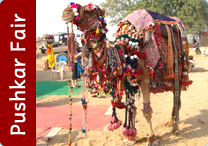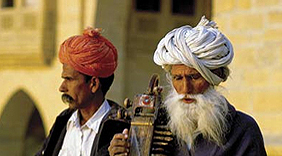
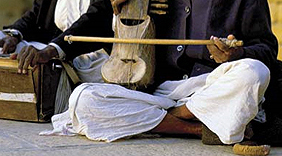

Custom Made Tour
Feel free to let us know if you are looking for customize tour program as all the tour itinerary is sample it can be modify according to your requirements.
Rajasthan Heritage Tour with Wildlife
Duration : 17 Nights / 18 DaysDestination : Delhi - Agra - Ranthambore - Jaipur - Chittaurgarh - Udiapur - Kumbalgarh - Jodhpur - Jaisalmer - Bikaner - Mandwa - Delhi

Rajasthan Heritage Tour with Wildlife Highlight
| City | Tour Highlight |
| Delhi | Red Fort, Raj Ghat, Jama Masjid, Chandni Chowk, India Gate, President's House, Humayun's Tomb & Qutub Minar Optional Sound & Light Show at Red Fort with dinner at Chor Bizarre |
| Agra | Taj Mahal, Agra Fort and Fatehpur Sikri |
| Jaipur | Elephant ride to Amber Fort Palace , City Palace, Jantar Mantar (Observatory) & Hawa Mahal (Palace of Winds) Optional Cultural evening at Chokhi Dhani |
| Jodhpur | Mehrangarh Fort & Jaswant Thada |
| Udaipur | City Palace, Sahelion Ki Bari, Lok Kala Museum & Boat Ride at Lake Pichola |
| Jaisalmer | Jaisalmer Fort , Jain Temple, Patwon Ki Haveli & Camel Safari |
| Ranthambore | Tiger and other wildlife attractions. |
| Chittaurgarh | Chittor Fort, Rana Kumbha Palace, Victory Tower, Palace of Rani Padmini, Tower of Fame & Palace of Patta & Jaimal |
| Bikaner | Junagarh Fort & Lal Garh Palace |
| Mandawa | Havelis (Mansion) of Goenka, Gori Shankar & Choudaharia with Frescoes |
Day 01 : Arrive Delhi
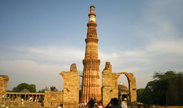
Later in first half of 20th century much of New Delhi was planned by Sir Edwin Lutyens, who laid out a grandiose central administrative area as a testament to British rule in India. The division in walled city & New Delhi also marks the division in life styles.
Overnight Hotel - Delhi
Day 02 : Delhi
Today we take a guided tour of Old Delhi, the 17th century walled city of Shah Jehanabad, Visiting the great Jama Masjid, the principal mosque of Old Delhi. Built in the year 1656 AD by the Mughal Emperor Shah Jahan, it is the largest & best known mosque in India. Later we walk down or take a rickshaw ride through Chandi Chowk, the old marketplace of Shah Jahanabad now a picturesque bazaar to reach Red Fort, built in the year 1648 by Shah Jehan.
 In New Delhi, we visit Raj Ghat, memorial to the Father of the Nation, Mahatma Gandhi. It is a simple black marble platform that marks the spot of his cremation on 31 January 1948. Further we drive past India Gate, memorial built in the year 1931 to commemorate the Indian soldiers who died in the World War I & the Afghan Wars. The names of the soldiers who died in these wars are inscribed on the walls. President's House, the official residence of the President of India, built in 1931. Until 1950 it was known as Viceroy's House & served as the residence of the Governor-General of British India. We will also visit Humayun's Tomb, memorial of Mughal Emperor Humayun, built in the year 1562. The complex is a World Heritage Site & the first example of this type of Mughal architecture in India. Qutub Minar, built in the year 1206 by Qutub-ud-din Aybak. It is the tallest (72m) brick minaret in the world, an important example of Indo-Islamic Architecture. Qutub Minar & its monuments are listed as a UNESCO World Heritage Site. Overnight Hotel - Delhi
In New Delhi, we visit Raj Ghat, memorial to the Father of the Nation, Mahatma Gandhi. It is a simple black marble platform that marks the spot of his cremation on 31 January 1948. Further we drive past India Gate, memorial built in the year 1931 to commemorate the Indian soldiers who died in the World War I & the Afghan Wars. The names of the soldiers who died in these wars are inscribed on the walls. President's House, the official residence of the President of India, built in 1931. Until 1950 it was known as Viceroy's House & served as the residence of the Governor-General of British India. We will also visit Humayun's Tomb, memorial of Mughal Emperor Humayun, built in the year 1562. The complex is a World Heritage Site & the first example of this type of Mughal architecture in India. Qutub Minar, built in the year 1206 by Qutub-ud-din Aybak. It is the tallest (72m) brick minaret in the world, an important example of Indo-Islamic Architecture. Qutub Minar & its monuments are listed as a UNESCO World Heritage Site. Overnight Hotel - Delhi Day 3 : Delhi - Agra (220 km - 5 hr)
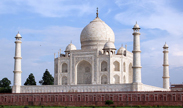
Later we visit Taj Mahal, symbol of eternal love, which stands on the banks of River Yamuna. It was built by the 5th Mughal Emperor, Shah Jahan in the year 1631 in memory of his wife, Mumtaz Mahal. It was completed in 22 years. Further we visit Agra Fort,taken over from the Lodhis by the Mughal Emperor Akbar in the late 16th century. The Fort can be more accurately described as a walled palatial city. It was built from red sandstone, often inlaid with white marble & intricate decorations. We will also visit Sikandara, Akbar's tomb. His son Jahangir completed the construction of the tomb in the year 1613. Overnight Hotel - Agra
Day 04 : Agra - Ranthambore via Fatehpur Sikri (260 kms/06 hour)
Today we drive to Ranthambore en route we will visit Fatehpur Sikri(Ghost Capital), the political capital of India's Mughal Empire under Akbar's reign, from the year 1571 until 1585, when it was abandoned, ostensibly due to lack of water. We visit Emperor Akbar's Residential complex, Mosque & Tomb of Salim Chisti.
Ranthambore National Park, bounded to the north by Banas River & to the Chambal River in the south. It is named after historic Ranthambore fortress, which lies within the park. The Park was established as Sawai Madhopur Game Sanctuary in the year 1955 by the Indian Government & was declared as Project Tiger reserves in the year 1973. It became National Park in the year 1980 & later in the year 1991 the tiger reserve was enlarged to include Sawai Man Singh & Keladevi sanctuaries, total area 1334 km.
It is famous for its tiger population & is one of India's Project Tiger reserves. Other Major wild animals found in the national park include the tiger, leopard, nilgai, dhole, wild pig, sambar, chital & the gaur. It is also home to wide variety of trees, plants, birds & reptiles
In the Evening, we take a Jeep safari to try luck in spotting the Tigers. Overnight at the wildlife resort.
Day 05 : Ranthambore
 Early morning today before Breakfast, we take Jeep Safari to the Tiger Reserve, since becoming one of the original areas under Project, the park has recovered much of its natural beauty & dry deciduous forest has been restored.
Early morning today before Breakfast, we take Jeep Safari to the Tiger Reserve, since becoming one of the original areas under Project, the park has recovered much of its natural beauty & dry deciduous forest has been restored. Later we visit the Ranthambore Fort, founded in the year 944 by the Chauhan Rajputs. After the defeat of the Chauhan king Prithviraj III by Muhammad of Ghori in the year 1192. It led by Govinda Raja, grandson of Prithviraj became the center of Chauhan resistance to the expanding Sultanate of Delhi. Later after many battles & rulers, it came in hands of Mughal Emperor Akbar in the year 1559. The fortress passed to the Kachhawa Maharajas of Jaipur in the 17th century & it remained part of Jaipur state until Indian Independence. The area surrounding the fortress became a hunting ground for the Maharajas of Jaipur. After lunch take jeep safari evening free at resort. Overnight at the wildlife resort
Day 06 : Ranthambore - Jaipur (190km - 4hr)
Take early morning jeep safari, after breakfast drive to Jaipur popularly known as Pink City, the flamboyant & colourful capital of Rajasthan. With its rich & colourful past, resplendent with tales of valour & bravery, it is now one of the most important heritage cities in India. The city was founded in 1728 by Maharaja Sawai Jai Singh II, the ruler of Amber. It remains the only city in the world symbolizing the nine divisions of the universe, through nine rectangular sectors. Overnight Hotel - Jaipur
Day 07 : Jaipur
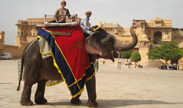
Later we visit the City Palace, a perfect blend of Rajasthani & Mughal architecture. The center of the palace is a seven-storied building called Chandra Palace, with fine views over the gardens & the city. Further we visit Jantar Mantar, the Solar Observatory, an astronomical treasure house, with solar devices that give accurate predictions till date. We now visit Hawa Mahal (Palace of Winds), a five-storied structure of pink sandstone. It was built in the year 1799 so that veiled royal women could peer down the busy street market unseen by the world through its 593 stone Jharokas (mini windows). Overnight Hotel - Jaipur
Day 08 : Jaipur – Chittaurgarh via Kota (290 km – 06 hr)
Today we drive to Chittaurgarh En route we visit Kota, along the eastern bank of the Chambal River lies an amazing juxtaposition of the majestic medieval age & modern industrialisation temples its untouched wealth of impressive forts, opulent palaces & splendid temples dating back over several centuries retain the past glory. The city was formed in the year 1572 Maharao.
We visit Sukh Niwas, build by Maharaja Umed Singh II in the year 1905. Maharaja Umed Singh II commissioned Sir Swinton Jacob, a distinguished officer of the Royal Engineers in the British Army, to design the building. As expected, Umed Bhawan came up in 1905 in the prevalent Indo-Saracenic style Plentiful supply of white Khimach & Pink Sandstone from nearby quarries helped, while Italian marble, among other things, had to be imported for flooring. The Palace truly offers a royal ambience & is a majestic sight in Kota. In 1930, a new wing was added to the existing palace, which is still the residence of the royal family of Kota. Next we visit the Jag Mandir, amid the picturesque artificial lake of Kishore Sagar constructed in the year 1346 AD by Prince Dher Deh. The azure water around the red-sandstone monument enhances its beauty. Boat-rides can be enjoyed in the lake. The Keshar Bagh famous for its royal cenotaphs lies in the vicinity.
 Later we drive to Chittorgarh, an ancient city in Rajasthan. It lies on the Berach River, a tributary of the Banas, & a former capital of the erstwhile kingdom of Mewar. By the 16th century, Mewar had become the leading Rajput state. After the Mughal Emperor Akbar captured Chittorgarh in the year 1568, the capital was moved west to Udaipur, in the foothills of the Aravalli Range, where Rana Udai Singh II had established a residence in 1559. However, Chittorgarh remains replete with historic associations & hold a special place in the hearts of many Rajputs, as it was a bastion of the clan at a time when every other stronghold had succumbed to invasion.
Later we drive to Chittorgarh, an ancient city in Rajasthan. It lies on the Berach River, a tributary of the Banas, & a former capital of the erstwhile kingdom of Mewar. By the 16th century, Mewar had become the leading Rajput state. After the Mughal Emperor Akbar captured Chittorgarh in the year 1568, the capital was moved west to Udaipur, in the foothills of the Aravalli Range, where Rana Udai Singh II had established a residence in 1559. However, Chittorgarh remains replete with historic associations & hold a special place in the hearts of many Rajputs, as it was a bastion of the clan at a time when every other stronghold had succumbed to invasion.Overnight Hotel – Chittaurgarh
Day 09 : Chittaurgarh – Udaipur (150 km – 03 hr)
Here we visit Chittor Fort (Battlefields of battles between the Ranas of Chittor & Alauddin Khilji, Sultan Bahadur Shah of Gujarat & Emperor Akbar.] It is a massive structure with zigzag accent to it. The road leads through seven gates to the main gate Rampol (Gate of Ram). The main gate of the fort itself is Surajpol (Sun Gate). Within the fort a circular runs around the ruins of the fort. According to often told legend the construction of the fort was started by Bhim a Pandava hero of mythological epic Mahabharata. The fort has many magnificent monuments. Even though the fort is ruin but it is an overwhelming reminder of past history & its walls resonate with unbelievable legend of extra ordinary men & women & their equally astounding deeds. During the visit we also visit Rana Kumbha Palace, ruined edifice of great historical & architectural interest, being the most massive monument in the fort of Chittaur. The palace is believed to have underground cellars where Rani Padmini & other women committed Jauhar.
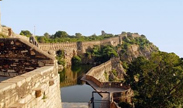
Palace of Patta & Jaimal, stand on a rocky rise south of Gomukh Kund. Both warrior heroes died in the third sack of Chittaur fighting the forces of Emperor Akbar.
Later we Continue drive to Udaipur, was founded in the year 1568 by Maharana Udai Singh after his final unsuccessful attempt to defend the Mewar capital, Chittorgarh from the invading Mughals under Emperor Akbar. The Kingdom of Mewar was considered the most respectable among all Princely states in Rajasthan & still remembered for the courage to protect the Kingdom. The site for Udaipur was chosen for its natural beauty, abundant water & natural protection afforded by the surrounding forests & Aravali mountains. It is set on the edge of three lakes & also known as the "City of Lakes & Palaces". Undoubtedly one of the most romantic cities in India, it’s beautiful Palaces are mirrored in the calm waters of Lake Pichola & the city is a brilliant kaleidoscope of narrow lanes flanked by bright stalls, gardens, lakes, palaces & temples. Overnight Hotel – Udaipur.
Day 10 : Udaipur
 Today we visit the City Palace, an intriguing collection of buildings contributed by various Maharanas (Kings) after Udai Singh & built in the year 1725. The magnificence of the Palace starts right from its entrance at the northern Tripolia Gate that brings us to the central courtyard, the best place to view the facade of filigreed balconies & ornate cupola-topped towers. Sahelion ki Bari (Garden of Maids of Honour) is an ornamental garden built by Maharana Sangram Singh for his daughter & the Ladies of the Queen's court. He built the garden with several fountains, pools & is decorated with chiselled pavilions & elephants. The fountains worked on the unique hydraulic technique devised in the year 1700 AD & work till today.
Today we visit the City Palace, an intriguing collection of buildings contributed by various Maharanas (Kings) after Udai Singh & built in the year 1725. The magnificence of the Palace starts right from its entrance at the northern Tripolia Gate that brings us to the central courtyard, the best place to view the facade of filigreed balconies & ornate cupola-topped towers. Sahelion ki Bari (Garden of Maids of Honour) is an ornamental garden built by Maharana Sangram Singh for his daughter & the Ladies of the Queen's court. He built the garden with several fountains, pools & is decorated with chiselled pavilions & elephants. The fountains worked on the unique hydraulic technique devised in the year 1700 AD & work till today.Later we visit Jagdish Temple, the Indo-Aryan temple, built in the year 1651 AD by Maharana Jagat Singh, is the largest & the most beautiful temple of Udaipur with noteworthy sculpted images. We also enjoy boat ride on Lake Pichola, the beauty of the lake is enhanced by the surrounding hills, palaces, temples, bathing ghats & embankments. The Jag Niwas (Lake Palace) & Jag Mandir, the two island palaces on the lake look like pearls in the lake. Overnight Hotel – Udaipur.
Day 11 : Udaipur – Kumbalgarh (100Km- 02 hr)
Today we drive Kumbalgarh, Rana Kumbha the legendary Mewar hero, an astute & a great builder. Of others, Kumbalgarh is the most inspiring. A joy for the nature lovers, it is surrounded by greenery & wildlife. It is also within a short driving distance from the famous 15th century Ranakpur Jain Temples. An area steeped in history & abounding in wildlife, unspoilt nature harmonizes with the modern comforts & the warm hospitality of the Aoudhi.Overnight Hotel – Kumbalgarh
Day 12 : Kumbalgarh – Jodhpur via Ranakpur (280km – 06 hr)
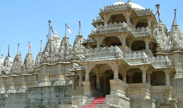
En route Ranakpur
Ranakpur, located in the mountain ranges of Pali. We visit the famous Ranakpur Jain Temples were built during the reign of the liberal & gifted monarch Rana Kumbha in the 15th century. An enormous basement covers 48,000 sq. feet area. There are four subsidiary shrines, 24 pillared halls & eligibly domes supported by over four hundred columns. The artistically carved nymphs playing the flute in various dance postures at a height of 45 feet are an engrossing sight. In the assembly hall, there are two big bells weighing 108 kg whose sound echoes in the entire complex. Overnight Hotel – Jodhpur
Day 13 : Jodhpur
Today we visit the Mehrangarh Fort (majestic fort), built by Rao Jodha, located atop a 125m high hill. The fort museum houses an exquisite collection of palanquins, howdah (Elephant saddle), royal cradles, miniatures, costumes & furniture. We also visit the Jaswant Thada, a white marble memorial built in the year 1899 in memory of Maharaja Jaswant Singh II. It is an architectural landmark in Jodhpur.
Later we also visit the Guda Bishnoi Village, a world of tribal colour & rustic cultural grandeur. A tour to the village in open air jeeps, visit various traditional villages, look at local handicrafts like shoe makers, pottery, hand weaving. Bishnois are an integral part of this region, a very hard working & hospitable tribal community. It is a wonderland where wild animals walk past village huts & villagers prefer to sleep without food so that animals are fed. They are ready to die to save the trees & nature & lead a pure vegetarian & clean life according to tenets preached by religious guru, Jambaji. They worship nature in all its forms & pray to green trees & animals that inhabit their land & thus make every effort to conserve environment. A noticeable fact about Bishnois is that they pray to Hindu deity Lord Vishnu & bury their dead like Muslims. Overnight Hotel – Jodhpur.
Day 14 : Jodhpur – Jaisalmer (290 kms – 06 hours)
 Today we drive to Jaisalmer, founded in the year 1156 by Bhatti Rajput ruler Rawal Jaisal. Often described as Golden City & rising from the heart of the Thar Desert like a golden mirage the commanding Fort etched in yellow sandstone, dominates the amber-hued city with its entire awesome splendour. Because of its strategic location it was an important ancient trading centre & camel caravans laden with precious spices & silk crossed the territory en-route India, Sindh, Arabia & Europe. The merchants of the 19th century built Havelis (Mansions) that are exquisitely carved from golden-yellow sandstone & are still in a beautiful condition. The life within the Fortified town conjures up images of medieval majesty visible in its narrow lanes strewn with magnificent palace, havelis, temples, & of course skilled artisans & ubiquitous camels. Overnight Hotel – Jaisalmer
Today we drive to Jaisalmer, founded in the year 1156 by Bhatti Rajput ruler Rawal Jaisal. Often described as Golden City & rising from the heart of the Thar Desert like a golden mirage the commanding Fort etched in yellow sandstone, dominates the amber-hued city with its entire awesome splendour. Because of its strategic location it was an important ancient trading centre & camel caravans laden with precious spices & silk crossed the territory en-route India, Sindh, Arabia & Europe. The merchants of the 19th century built Havelis (Mansions) that are exquisitely carved from golden-yellow sandstone & are still in a beautiful condition. The life within the Fortified town conjures up images of medieval majesty visible in its narrow lanes strewn with magnificent palace, havelis, temples, & of course skilled artisans & ubiquitous camels. Overnight Hotel – JaisalmerDay 15 : Jaisalmer
Today we visit the old town of Jaisalmer & visit Jaisalmer Fort, built in the year 1156 by Rawal Jaisal. Perched on 80m high hill, housing the entire township within its ramparts, the golden hued Fort is standing like a sentinel in the bleak desert landscape. It is the only “Living Fort” in India & within its ramparts has an enchanting cow-web of narrow lanes dotted with some lovely Havelis (Mansions), Palaces & beautifullysculptured Jain Temples of the 12th-15th century AD & of course skilled artisans & ubiquitous camels.
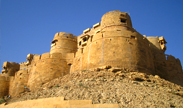
Overnight Hotel – Jaisalmer
Day 16 : Jaisalmer – Bikaner (325km - 6hour)
Today we drive to the princely state of Bikaner, founded by Rao Bikaji (1465-1504 AD) in the year 1488 AD. He was a Rajput prince, descendent of the founder of neighboring Jodhpur. It lies in the north-western part of Rajasthan & has a stark beauty of the desert landscape with wide-spread sand dunes & thorny shourubs growing around. It is a royal city surrounded by a mammoth fortification wall, more than 5 km in circumference & about 5 to 9m high. Fort, Palaces & people with colorful traditional costumes are the chief attractions of the city. The Camel Breeding Farm in Bikaner is only one of its kinds in the whole Asia & so is the illustrious Camel Festival.
Overnight Hotel – Bikaner
Day 17 : Bikaner – Mandawa (200 km – 04 hour)
 Today in Bikaner we visit Junagarh Fort, built in the year 1593 AD by Raja Rai Singh (1571-1612 AD), the 6th ruler of Bikaner. The Fort is a formidable structure & largely remained unconquered during its eventful history. It houses number of beautiful Palaces, Temples & Pavilions, which are richly decorated The beautifully maintained rooms of Anup Mahal now display the treasures of the Royal family. The Fort Museum has an extensive collection of illuminated manuscripts, jewellery, jars, carpets, weapons, treaties, decorations & Farmans (King’s Orders).
Today in Bikaner we visit Junagarh Fort, built in the year 1593 AD by Raja Rai Singh (1571-1612 AD), the 6th ruler of Bikaner. The Fort is a formidable structure & largely remained unconquered during its eventful history. It houses number of beautiful Palaces, Temples & Pavilions, which are richly decorated The beautifully maintained rooms of Anup Mahal now display the treasures of the Royal family. The Fort Museum has an extensive collection of illuminated manuscripts, jewellery, jars, carpets, weapons, treaties, decorations & Farmans (King’s Orders).Later we drive to Mandawa in the heart of the semi-arid Shekhawati region. Shekhawati owes its name to Rao Shekha who ruled this area in the 14th century. The Fort of Mandawa was built in the year 1755 by Thakur Nawal Singh, the founder of the town. These were the times when Mandawa was settled & fortified by the rich & dominant Silk Route merchants of the region, who constructed many Havelis (Mansions), Chhatris (Cenotaphs), Temples & Baolis (Step-wells) with ornate frescoes adorning their walls & now aptly given the epithet – Open-Air Gallery. With the migration of these merchant families, their old settlements remained in total obscurity with no one to look after them. Mandawa still retains the charm & aura of a bygone era & coming here is like stepping into a different world.
Overnight Hotel – Mandawa
Day 18 : Mandawa – Delhi (280 kms – 06 hours)
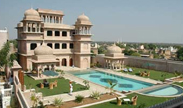
Later we continue our drive to Delhi, upon arrival in Delhi Transfer to Airport for onward Destination.


